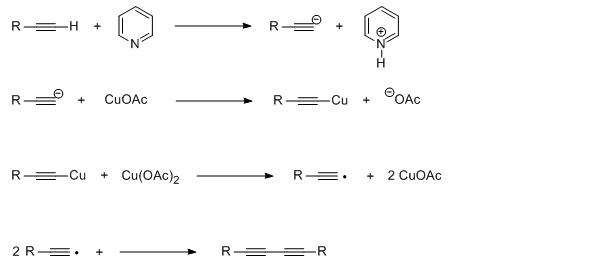Glaser coupling
| Glaser coupling | |
|---|---|
| Named after | Carl Andreas Glaser |
| Reaction type | Coupling reaction |
| Identifiers | |
| Organic Chemistry Portal | glaser-coupling |
| RSC ontology ID | RXNO:0000098 |
The Glaser coupling is a type of coupling reaction. It is by far the oldest acetylenic coupling and is based on cuprous salts like copper(I) chloride or copper(I) bromide and an additional oxidant like oxygen. The base in its original scope is ammonia. The solvent is water or an alcohol.[1][2] The reaction was first reported by Carl Andreas Glaser in 1869.

Modifications
Eglinton reaction
| Eglinton reaction | |
|---|---|
| Named after | Geoffrey Eglinton |
| Reaction type | Coupling reaction |
| Identifiers | |
| Organic Chemistry Portal | eglinton-reaction |
| RSC ontology ID | RXNO:0000099 |
In the related Eglinton reaction[3] two terminal alkynes are coupled directly by a copper(II) salt such as cupric acetate.
The Eglinton Reaction[4] has been used to synthesize a number of fungal antibiotics and is important for carbon-carbon bond formation via the oxidative coupling of alkynes.[5]
This procedure was used in the synthesis of cyclooctadecanonaene.[6] Another example is the synthesis of diphenyldiacetylene from phenylacetylene.[7]
Hay coupling
The Hay coupling (1962) is another version of the Glaser coupling with the TMEDA complex of copper(I) chloride.[8] An example is the coupling of trimethylsilylacetylene.[9]
Scope
In 1882 Adolf von Baeyer used the method to synthesise indigo dye from 3-(2-nitrophenyl)propiolic acid.[10][11]

Shortly afterwards, Baeyer reported a different route to indigo, now known as the Baeyer–Drewson indigo synthesis.
See also
- Cadiot–Chodkiewicz coupling - Another alkyne coupling reaction catalysed by copper (I).
- Sonogashira coupling - Pd/Cu catalysed coupling of an alkyne and an aryl or vinyl halide
- Castro–Stephens coupling - A cross-coupling reaction between a copper(I) acetylide and an aryl halide
- Fritsch–Buttenberg–Wiechell rearrangement - can also form diynes
References
- ↑ Glaser, Carl. "Untersuchungen über einige Derivate der Zimmtsäure". Annalen der Chemie und Pharmacie. 154 (2): 137–171. doi:10.1002/jlac.18701540202.
- ↑ Glaser, C. "Beiträge zur Kenntniss des Acetenylbenzols". Berichte der deutschen chemischen Gesellschaft. 2 (1): 422–424. doi:10.1002/cber.186900201183.
- ↑ G. Eglinton and A. R. Galbraith, J. Chem. Soc., 889 (1959).
- ↑ Eglinton, G.; Galbraith, A. R.; Chem. Ind. 1956, 737.
- ↑ Eglinton, G.; McRae, W. Adv. Org. Chem. 1963, 4, 225.
- ↑ K. Stöckel and F. Sondheimer (1988). "[18]Annulene". Org. Synth.; Coll. Vol., 6, p. 68
- ↑ I. D. Campbell and G. Eglinton (1973). "Diphenyldiacetylene". Org. Synth.; Coll. Vol., 5, p. 517
- ↑ Hay, Allan S. "Oxidative Coupling of Acetylenes. II". The Journal of Organic Chemistry. 27 (9): 3320–3321. doi:10.1021/jo01056a511.
- ↑ Graham E. Jones, David A. Kendrick, and Andrew B. Holmes (1993). "1,4-Bis(trimethylsilyl)buta-1,3-diyne". Org. Synth.; Coll. Vol., 8, p. 63
- ↑ Baeyer, Adolf. "Ueber die Verbindungen der Indigogruppe". Berichte der deutschen chemischen Gesellschaft. 15 (1): 50–56. doi:10.1002/cber.18820150116.
- ↑ Johansson Seechurn, Carin C. C.; Kitching, Matthew O.; Colacot, Thomas J.; Snieckus, Victor (21 May 2012). "Palladium-Catalyzed Cross-Coupling: A Historical Contextual Perspective to the 2010 Nobel Prize". Angewandte Chemie International Edition. 51 (21): 5062–5085. doi:10.1002/anie.201107017.
